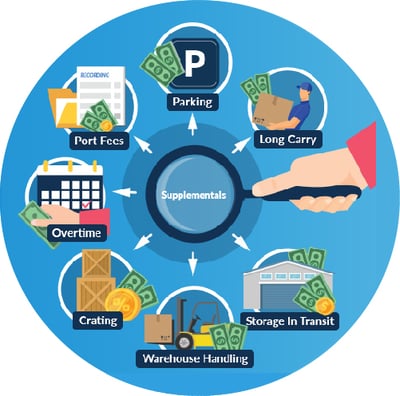Sep 13, 2022 Top 10 Things You Might Not Know About Household Goods Moving
By Ben Heller
One of our core missions at PricePoint is to make household goods move pricing and procurement work better for everyone, so we’ve put together this simple Top 10 to tackle some common questions and assumptions surrounding household goods move management.
1. There's no such thing as the best mover
We’re often asked, “who is the best mover?” The reality is, there is no such thing. There is only one best mover for a given situation. Every mover has their own unique strengths, be it in capacity, geography, or services offered. For RMCs and corporate mobility customers, it’s especially important to identify movers who best fit your unique needs.

2. There’s a difference between movers and move methodologies
RMCs often build their moving networks with a group of suppliers that offer good overall quality and reach, then randomly distribute those moves among their network. Even though this is done in the interest of fairness, random distribution is not a good strategy. Choosing the right mover and moving methodology for each move can have a huge impact on both transferee experience and your company's bottom line.
3. There's more to a consider than just the cost
Moving is expensive. HHG moving represents 10-20% of your mobility program’s total addressable spend, so it stands to reason why lowest price wins business. The problem is, lowball pricing has its costs. Movers are facing significant cost increases to just about every aspect of their business. Unfortunately for movers and their clients, tight profit margins often means compromised quality and service down the line - directly impacting transferees.
4. There are more ways to move than ever before
Corporate mobility managers should get knowledgeable about new moving methodologies in order to be responsive to a changing marketplace and changing transferee needs. Last summer’s capacity crunch forced companies to try different options: containerized, small crates, local movers - even hired labor and a rental truck. The moving industry is evolving and innovating all the time, and it’s vital for mobility professionals to know what options are available, how to source them, and most importantly – when to use them.
5. There are many opportunities for unexpected surcharges
Supplementals are a catch-all category of moving services, necessary because they accommodate circumstances unique to each move like oversized furniture, art, elevators, stair carries, or residential street access. All of these services carry additional costs that go above and beyond basic weight and distance. As with claims and quality, there is no such thing as an industry standard for supplementals, leaving customers vulnerable to unscrupulous movers who exploit these charges. Supplementals are also not typically included in the RFP process, so it’s important for customers to know what they are and the impact they can have on your moving program costs.
Supplementals can account for 20% of your total move costs, so it's worth understanding what they are and where they are coming from. With PricePoint, you can measure the frequency and average costs of unusual charge types and compare your mover's performance to market averages by each category.
6. There's no true way to quantify quality and claims
"Claims" and "quality" are terms that are often correlated: it should stand to reason that a quality mover would be one with a low claims score. But it’s impossible to measure quality and claims with any consistency because these things are measured differently between movers. The claims threshold (dollar amount) varies from mover to mover, and lower cost claims are often settled with cash off-the-record. Further, quality is an entirely subjective score based on the transferee’s overall satisfaction with the move experience. Even when Service Level Agreements are in place, without an industry standard it is easy to manipulate these scores.
7. There are highly elaborate pricing schedules being used
Tariffs are the universal backbone of move pricing. But each van line tariff is different, cumbersome, and almost impossible for a non-mover to comprehend. Each tariff has its own unique rules that determine what’s included, how valuation is determined, and how pricing is calculated, making any apples-to-apples comparisons very difficult to determine. Tariffs are also a mover’s best-kept secret, so there is abundant room for discretion when it comes to pricing a move. For example, if you were to compare a 64% to a 68% discount you won’t really know which one is cheaper unless you’re done a full analysis of one mover’s 120-page tariff and compared it to another.
8. There are better ways to build your moving network than with an RFP
Most HHG moving RFPs simply aren’t worth the time. Why? For many of the reasons we’ve outlined here: "best movers" are subjective; movers will bid low to win the business then run up costs on supplementals; and once the program is live there are too many factors outside your control to manage (like quoted vs. actual lanes). Sometimes, the best course of action is to optimize your existing supplier pool rather than reset your entire program with a protracted, painful RFP process.
9. There is value in transparent partnerships
Some mobility programs are managed through an RMC. Their commitment is to act as the intermediary between your transferees and their move partners, managing the details to ensure every aspect of the move is delivered as planned. It’s a tremendous responsibility to carry, so your RMC will rightly make money on each of your moves. But chances are you only see the final invoice, not the full breakdown of the costs for each move. For some companies, this is an acceptable trade-off, but for others, managing costs can be a bigger consideration.

10. There are significant cost savings to be found in your moving program. PricePoint can help you find them.
PricePoint works with more than 1,000 movers worldwide and has more than 1M tariffs in our system. We can help you objectively benchmark your mobility program, identify opportunities for cost savings, and work to improve service delivery for your transferees. Talk to us about how we can help streamline your moving program, increase transparency, and build better relationships with your moving services partners.
If you have any questions, reach out. We’re always glad to help.
CEO Ben fell in love with the mobility industry while running Accentureʼs global mobility consulting practice. Focusing on the mobility supply chain, he learned the hard way that move pricing is complicated, unclear, and vulnerable to manipulation. After evaluating all existing alternatives, Ben partnered with Ryan to make data-driven moving decisions possible.


